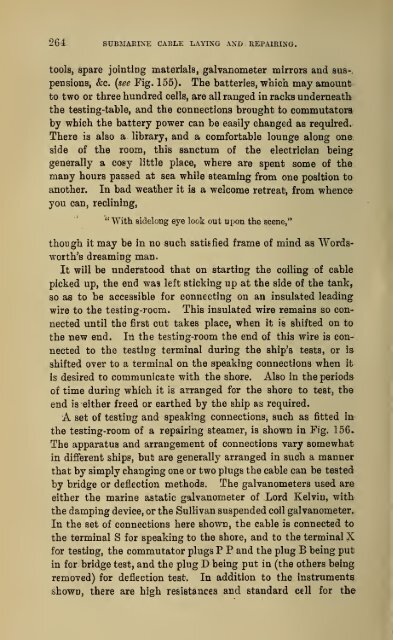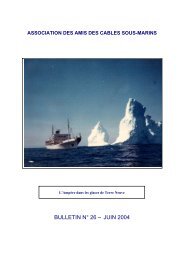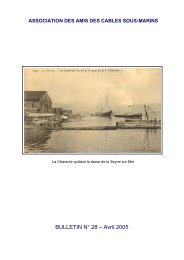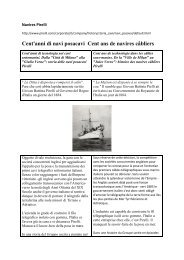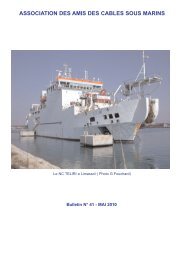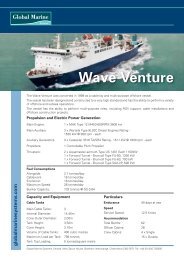- Page 2:
%f h ZU Institution of €kctrical
- Page 8 and 9:
Printed and Published by 'THE ELECT
- Page 10 and 11:
iv. PREFACE. past, 1 think there wi
- Page 13 and 14:
PREFACE TO SECOND EDITION. THIS wor
- Page 15 and 16:
appeared. Mr. Charles Bright, F.R.S
- Page 17 and 18:
Selection of Route Soundings Tubes
- Page 19 and 20:
CHAPTER IV. — TABLE OF CONTENTS.
- Page 21 and 22:
INDEX TO ILLUSTRATIONS. Bows ANB Bo
- Page 23 and 24:
INDEX TO ILLUSTBATIONS. XVll. Dynam
- Page 25 and 26:
MiEROE. — Continued. Rymer-Jones'
- Page 27 and 28:
Sounding. INDEX TO ILLUSTEATIONS. J
- Page 29:
Tests and Testing.—Continued. IND
- Page 32 and 33:
Z SUBMARINE CABLE LAYING AND REPAIR
- Page 34 and 35:
4 SUBMAKINE CABLE LAYING AND BBPAIE
- Page 36 and 37:
t> SUBMARINE CABLE LAYING AND BEPAI
- Page 38 and 39:
8 SUBMARINE CABLE LAYING AND EEPAIR
- Page 40 and 41:
10 SUBMARINE CABLE LAYING AND REPAI
- Page 42 and 43:
12 SUBMABINE CABLE LAYING AND REPAI
- Page 44 and 45:
14 SUBMAEINE CABLE LAYING AND REPAI
- Page 46 and 47:
16 SUBMARINE CABLE LAYING AND RPPAI
- Page 48 and 49:
18 SUBMARINE CABLE LAYING AND REPAI
- Page 50 and 51:
20 SUBMARINE CABLE LAYING AND REPAI
- Page 52 and 53:
22 SUBMARINE CABLE LAYING AND REPAI
- Page 54 and 55:
24 SUBMARINE CABLE LAYING AND REPAI
- Page 56 and 57:
26 SUBMARINE CABLE LAYING AND REPAI
- Page 58 and 59:
28 SUBMARINE CABLE LAYING AND REPAI
- Page 60 and 61:
30 SUBMABINE CABLE LAYING AND REPAI
- Page 62 and 63:
32 SUBMAEINE CABLE LAYING AND REPAI
- Page 64 and 65:
34 SUBMARINE CABLE LAYING AND REPAI
- Page 66 and 67:
36 SUBMAEINB CABLE LAYING AND REPAI
- Page 68 and 69:
38 SUBMARINE CABLE LAYING AND KEPAI
- Page 70 and 71:
40 SUBMAEINE CABLE LAYING AND EEPAI
- Page 72 and 73:
42 SUBMARINE CABLE LAYING AND REPAI
- Page 74 and 75:
44 SUBMAKINE CABLE LAYING AND KEPAI
- Page 76 and 77:
46 SUBMAEINE CABLE LAYING AND KEPAI
- Page 78 and 79:
48 SUBMARINE CABLE LAYING AND REPAI
- Page 80 and 81:
00 SUBBIAEINE CABLE LAYING AND REPA
- Page 82 and 83:
52 SUBMARINE CABLE LAYING AND REPAI
- Page 84 and 85:
4 SUBMAEINE CABLE LAYING AND REPAIR
- Page 86 and 87:
56 SUBMARINE CABLE LAYING AND KEPAI
- Page 88 and 89:
58 SUBMARINE CABLE LAYING AND REPAI
- Page 90 and 91:
60 SUBMABINE CABLE LAYING AND EEPAI
- Page 92 and 93:
62 SUBMAEINE CABLE LAYING AND REPAI
- Page 94 and 95:
64 SUBMARINE CABLE LAYING AND REPAI
- Page 96 and 97:
66 SUBMAEINE CABLE LAYING AND REPAI
- Page 98 and 99:
66 SUBMAEINE< CABLE LAYING AND EEPA
- Page 100 and 101:
70 SUBMAKINE CABLE LAYING AND REPAI
- Page 102 and 103:
72 SUBMAKINE CABLE LAYING AND KEPAI
- Page 104 and 105:
74 SUBMAKINE CABLE LAYING AND REPAI
- Page 106 and 107:
76 SUBMARINE CABLE LAYING AND KEPAI
- Page 108 and 109:
78 SUBMAKINE CABLE LAYING AND EEPAI
- Page 110 and 111:
80 SUBMAKINE CABLE LAYING AND KEPAI
- Page 112 and 113:
82 SUBMAKINE CABLE LAYING AND KEPAI
- Page 114 and 115:
84 SUBMAEINE CABLE LAYING AND KEPAE
- Page 116 and 117:
86 SUBMARINE CABLE LAYING AND REPAI
- Page 118 and 119:
88 SUBMARINE CABLE LAYING AND EEPAI
- Page 120 and 121:
90 SUBMAKINE CABLE LAYING AND REPAI
- Page 122 and 123:
92 SUBMAKINE CABLE LAYING AND EBPAI
- Page 124 and 125:
94 SUBMABINE CABLE LAYING AND KEPAI
- Page 126 and 127:
96 SUBMABINE CABLE LAYING AND EEPAI
- Page 128 and 129:
98 SUBMAKINE CABLE LAYING AND REPAI
- Page 130 and 131:
100 SUBMARINE CABLE LAYING AND REPA
- Page 132 and 133:
102 SUBMARINE CABLE LAYING AND REPA
- Page 134 and 135:
104 SUBMARINE CABLE LAYING AND REPA
- Page 136 and 137:
106 SUBMAKINE CABLE LAYING AND EEPA
- Page 138 and 139:
108 SUBMARINE CABLE LAYING AND REPA
- Page 140 and 141:
110 SUBMARINE CABLE LAYING AND REPA
- Page 142 and 143:
112 SUBMARINE CABLE LAYING AND REPA
- Page 144 and 145:
114 SUBMARINE CABLE LAYING AND REPA
- Page 146 and 147:
116 SUBMARINE CABLE LAYING AND REPA
- Page 148 and 149:
118 SUBMARINE CABLE LAYING AND REPA
- Page 150 and 151:
120 SUBMARINE CABLE LAYING AND REPA
- Page 152 and 153:
122 SUBMAKINB CABLE LAYING AND REPA
- Page 154 and 155:
124 SUBMAEINE CABLE LAYING AKD REPA
- Page 156 and 157:
126 SUBMARINE CABLE LAYING AND REPA
- Page 158 and 159:
128 SUBilARIXE CABLE LAYI^"G AXD RE
- Page 160 and 161:
130 SUBMARINE CABLE LAYING AND REPA
- Page 162 and 163:
132 SUBMARINE CABLE LAYING AND KEPA
- Page 164 and 165:
134 SUBMARINE CABLE LAYING AND KEPA
- Page 166 and 167:
136 SUBMARINE CABLE LAYING AND REPA
- Page 168 and 169:
138 SUBMARINE CABLE LAYING AND EEPA
- Page 170 and 171:
140 SUBMARINE CABLE LAYING AND EEPA
- Page 172 and 173:
142 SUBMARINE CABLE LAYING AND EEPA
- Page 174 and 175:
144 SUBMARINE CABLE LAYING AND REPA
- Page 176 and 177:
146 SUBMARINE CABLE LAYING AND REPA
- Page 178 and 179:
148 SUBMARINE CABLE LAYING AND KEPA
- Page 180:
150 SUBMAKINE CABLE LAYING AND EEPA
- Page 183 and 184:
THE LAYING OF SUBMARINE CABLES. 151
- Page 185 and 186:
THE LAYING OF SUBMARINE CABLES. 153
- Page 187 and 188:
THE LAYING OF SUBMARINE CABLES. 155
- Page 189 and 190:
THE LAYING OF SUBMARINE CABLES. 157
- Page 191 and 192:
THE LAYING OF SUBMARINE CABLES. 159
- Page 193 and 194:
THE LAYING OF SUBMARINE CABLES. 161
- Page 195 and 196:
THE LAYING OF SUBMARINE CABLES. 16a
- Page 197 and 198:
THE LAYING OF SUBMAKINE CABLES. 165
- Page 199 and 200:
THE LAYING OF SUBMARINE CABLES. 167
- Page 201 and 202:
THE LAYING OF SUBMARINE CABLES. 169
- Page 203 and 204:
THE LAYING OF SUBMARINE CABLES. 171
- Page 205 and 206:
THE LAYING OF SUBMARINE CABLES. 173
- Page 207 and 208:
THE LAYING OF SUBMAEINE CABLES. 175
- Page 209 and 210:
THE LAYING OF SUBMARINE CABLES. 177
- Page 211 and 212:
THE LAYING OF SUBBIAKINE CABLES. 17
- Page 213 and 214:
THE LAYING OF SUBMARINE CABLES. 181
- Page 215 and 216:
CHAPTER IV. THE CABLE SHIP ON REPAI
- Page 217 and 218:
THE CABLE SHIP ON REPAIRS. 185 in t
- Page 219 and 220:
THE CABLE SHIP ON REPAIRS. 187 and
- Page 221 and 222:
THE CABLE SHIP ON REPAIRS. 189 and
- Page 223 and 224:
THE CABLE SHIP ON REPAIRS. 191 ment
- Page 225 and 226:
THE CABLE SHIP ON REPAIRS. 193 ing
- Page 227 and 228:
THE CABLE SHIP ON RErAIRS. 195 abou
- Page 229 and 230:
THE CABLE SHIP ON REPAIRS. 197 hund
- Page 231 and 232:
THE CABLE Sllir ON REPAIRS. 199 upw
- Page 233 and 234:
THE CABLE SHir OX REPAIRS. 201 the
- Page 235 and 236:
THE CABLE SHIP ON REPAIRS. 203 to-d
- Page 237 and 238:
THE CABLE SHIP OX REPAIRS. 205 pron
- Page 239 and 240:
THE CAHLE SHIP OX REPAIRS. 207 by l
- Page 241 and 242:
THE CABLE SHIP OX REPAIRS. ^ 209 10
- Page 243 and 244:
THE CABLE SHIP ON REPAIRS. 211 come
- Page 245 and 246: THE CABLE SHIP ON REPAIRS. 2ia chai
- Page 247 and 248: THE CABLE SHIP ON REPAIRS. 215 In t
- Page 249 and 250: THE CABLE SHIP OX REPAIES. 217 show
- Page 251 and 252: THE CABLE SHIP ON REPAIRS. 219 Cabl
- Page 253 and 254: THE CABLE SHIP ON REPAIRS. 221 to t
- Page 255 and 256: THE CABLE SHIP OX REPAIES. - 223 sh
- Page 257 and 258: THE CABLE SHIP OX REPAIRS. 225 a bl
- Page 259 and 260: THE CABLE SHIP ON BEPAIES. 227 the
- Page 261 and 262: THE CABLE SHIP ON REPAIRS. 22& tota
- Page 263 and 264: THE CABLE SHIP ON REPAIRS. 231 Stea
- Page 265 and 266: THE CABLE SHIP ON REPAIRS. 233 Whil
- Page 267 and 268: THE CABLE SHIP ON REPAIRS. 235 dist
- Page 269 and 270: THE CABLE SHIP ON REPAIRS. 237 la t
- Page 271 and 272: THE CABLE SHIP ON KEPAIRS. 239 spac
- Page 273 and 274: THE CABLE SHiP ON REPAIKS. 241 very
- Page 275 and 276: THE CABLE SHIP ON REPAIRS. 243 unde
- Page 277 and 278: THE CABLE SHIP ON REPAIRS. 245 noti
- Page 279 and 280: THE CABLE SHIP ON EEPAIES. ~ 247 be
- Page 281 and 282: THE CABLE SHIP ON REPAIRS 249
- Page 283 and 284: THE CABLE SHIP ON REPAIRS. 251 H.M.
- Page 285 and 286: THE CABLE SBIP ON REPAIKS. 253 Befo
- Page 287 and 288: THE CABLE SHIP ON REPAIES. 255 medi
- Page 289 and 290: THE CABLE SHIP ON EEPAIES. 257 o o
- Page 291 and 292: THE CABLE SHIP ON REPAIRS. 259 In t
- Page 293 and 294: THE CABLE SHIP ON EEPAIES. 261
- Page 295: THE CABLE SHIP ON KEPAIRS. 263 intr
- Page 299 and 300: THE CABLE SHIP ON REPAIBS. 267 test
- Page 301 and 302: THE CABLE SHIP ON EEPAIKS. 269 When
- Page 303 and 304: THE CABLE SHIP ON KEPAIRS. 271 with
- Page 305 and 306: THE CABLE SHIP ON REPAIRS. 273 silv
- Page 307 and 308: THE CABLE SHIP ON REPAIRS. 275 ing
- Page 309 and 310: THE CABLE SHIP ON KSIPAIES. 277 fin
- Page 311 and 312: THE CABLE SHIP ON BEPAIRS. 279 ever
- Page 313 and 314: THE CABLE SHIP ON KEPAIRS. 281 the
- Page 315 and 316: THE CABLE SHIP ON REPAIRS. 283 of p
- Page 317 and 318: THE CABLE SHIP ON EEPAIES. 281 The
- Page 319 and 320: THE CABLE SHIP ON REPAIRS. 287 rope
- Page 321 and 322: THE CABLE SHIP ON REPAIKS. 289 at t
- Page 323 and 324: THE CABLE SHIP ON EEPAIES. 291 appe
- Page 325 and 326: THE CABLE SHIP ON REPAIRS, 293 Thes
- Page 327 and 328: THE CABLE SHIP ON EEPAIES. 295 whic
- Page 329 and 330: THE CABLE SHIP ON REPAIRS. 297 The
- Page 331 and 332: THE CABLE SHIP ON REPAIRS. 299 minu
- Page 333 and 334: THE CABLE SHIP ON REPAIRS. 301 for
- Page 335 and 336: THE CABLE SHIP ON EEPAIES. 303 like
- Page 337 and 338: THE CABLE SHIP ON REPAIRS. 305 Mr.
- Page 339 and 340: THE CABLE SHIP ON REPAIRS. mi latte
- Page 341 and 342: THE CABLE SHIP ON EEPATRS. 309 day
- Page 343 and 344: THE CABLE SHIP ON K|;PAIRS. 311 of
- Page 345 and 346: THE CABLE SHIP ON KEPAIRS. 313 pass
- Page 347 and 348:
THR CABLE SHIP ON REPAIRS. 315 spli
- Page 349:
CvJ gi £ LU ^ I « CO I < Ql Ul QC
- Page 352 and 353:
320 SUBMARINE CABLE LAYING AND REPA
- Page 354 and 355:
322 SUBMARINE CABLE LAYING AND REPA
- Page 356 and 357:
324 SUBMARINE CABLE LAYING AND REPA
- Page 358 and 359:
326 SUBMARINE CABLE LAYING AND REPA
- Page 360 and 361:
328 SUBMARINE CABLE LAYING AND REPA
- Page 362 and 363:
330 SUBMARINE CABLE LAYING AND KEPA
- Page 364 and 365:
332 SUBJIAKINE CABLE LAYING AND REP
- Page 366 and 367:
534 SUBHAKINE CABLE LAYING AND REPA
- Page 368 and 369:
336 SUBMARINE CABLE LAYING AND REPA
- Page 370 and 371:
338 SUBMARINE CABLE LAYING AND REPA
- Page 372 and 373:
340 SUBilAKINE CABLE LAYING AND KEP
- Page 374 and 375:
342 SUBMARINE CABLE LAYING AND REPA
- Page 376 and 377:
344 fSUBMARINE CABLE LAYING AND KEP
- Page 378 and 379:
346 ,23
- Page 380 and 381:
348 SUBMAEINE CABLE LAYING AND EEPA
- Page 382 and 383:
350 SUBMARINE CABLE LAYING AND EEPA
- Page 384 and 385:
352 SUBMAEINE CABLE LAYING AND KEPA
- Page 386 and 387:
354 SUBMAKINE CABLE LAYING AND REPA
- Page 388 and 389:
356 SUBMARINE CABLE LAYING AND REPA
- Page 390 and 391:
358 SUBMAKINE CABLE LAYING AND KEPA
- Page 392 and 393:
360 SUBMARINE CABLE LAYING AND KEPA
- Page 394 and 395:
362 SUBMAKINE CABLE LAYING AND EEPA
- Page 396 and 397:
364 SUBMARINE CABLE LAYING AND REPA
- Page 398 and 399:
366 SUBMAEINE CABLE LAYING AND BEPA
- Page 400 and 401:
368 SUBMAKINE CABLE LAYING AND EEPA
- Page 402 and 403:
370 SUBMAEINE CABLE LAYING ANP EEPA
- Page 404 and 405:
372 SUBMAEINE CABLE LAYING AND KEPA
- Page 406 and 407:
374 SUBMARINE CABLE LAYING AND EEPA
- Page 408 and 409:
376 SUBMAEINE CABLE LAYING AND EEPA
- Page 410 and 411:
78 SUBMAEINE GABLE LAYING AND KEPAl
- Page 412 and 413:
380 SUBMABINE CABLE LAYING AND REPA
- Page 414 and 415:
382 SUBMARINE CABLE LAYING AND REPA
- Page 416 and 417:
384 SUBMARINE CABLE LAYING AND REPA
- Page 418 and 419:
3S6 SUBMARINE CABLE LAYING AND REPA
- Page 420 and 421:
388 SUBMABINE CABLE LAYING AND BEPA
- Page 422 and 423:
390 SUBMARINE CABLE LAYING AND REPA
- Page 424 and 425:
392 SUBMARINE CABLE LAYING AND REPA
- Page 426 and 427:
394 SUBMARINE CABLE LAYING AND REPA
- Page 428 and 429:
396 SUBMARINE CABLE LAYING AND REPA
- Page 430 and 431:
398 SUBMARINE CABLE LAYING AND REPA
- Page 432 and 433:
400 SUBMABINE CABLE LAYING AND REPA
- Page 434 and 435:
402 SUBMABINE CABLE LAYING AND EEPA
- Page 436 and 437:
404 SUBMARINE CABLE LAYING AND REPA
- Page 438 and 439:
406 SUBMARINE CABLE LAYING AND REPA
- Page 440 and 441:
408 SUBMARINE CABLE LAYING AND REPA
- Page 442 and 443:
410 SUBMARINE CABLE LAYING AND REPA
- Page 444 and 445:
412 SUBMARINE CABLE LAYING AND REPA
- Page 446 and 447:
• 414 SUBMAEINE CABLE LAYING AND
- Page 448 and 449:
416 SUBMARINE CABLE LAYING AND REPA
- Page 450 and 451:
418 SUBMARINE CABLE LAYING AND REPA
- Page 452 and 453:
420 SUBMABINE CABLE LAYING AND REPA
- Page 454 and 455:
422 SUBMAEINE CABLE LAYING AND BEPA
- Page 456 and 457:
424 SUBMARINE CABLE LAYING AND REPA
- Page 458 and 459:
426 SUBMAEINE CABLE LAYING AND REPA
- Page 460 and 461:
428 SUBMAKINE CABLE LAYING AND EEPA
- Page 462 and 463:
430 SUBMARINE CABLE LAYING AND REPA
- Page 464 and 465:
432 SUBMAKINE CABLE LAYING AND REPA
- Page 466 and 467:
434 SUBMARINE CABLE LAYING AND REPA
- Page 468 and 469:
436 SUBMARINE CABLE LAYING AND REPA
- Page 470 and 471:
438 SUBMARINE CABLE LAYING AND KEPA
- Page 472 and 473:
440 SUBMAEINE CABLE LAYING AND KEPA
- Page 474 and 475:
442 SUBMARINE CABLE LAYING AND REPA
- Page 476 and 477:
444 SUBMARINE CABLE LAYING AJ^D REP
- Page 478 and 479:
446 SUBMARINE CABLE LAYING AND KEPA
- Page 480 and 481:
448 SUBMARINE CABLE LAYING AND EEPA
- Page 482 and 483:
450 SUBMARINE CABLE LAYING AND BEPA
- Page 484 and 485:
452 SUBMARINE CABLE LAYING AND REPA
- Page 486 and 487:
454 SUBMARINE CABLE LAYING AND REPA
- Page 488 and 489:
456 SUBMARINE CABLE LAYING AND REPA
- Page 490 and 491:
458 SUBMARINE CABLE LAYING AND REPA
- Page 492 and 493:
460 SUBMAKINE CABLE LAYING AND EEPA
- Page 494 and 495:
462 SUBBIAKINE CABLE LAYING AND REP
- Page 496 and 497:
464 SUEJIAEINE CABLE LAYING AND REP
- Page 498 and 499:
4G6 SUBMARINE CABLE LAYING AND BEPA
- Page 500 and 501:
468 SUBMARINE CABLE LAYING AND KEPA
- Page 502 and 503:
470 SUBMABINE CABLE LAYINa AND BEPA
- Page 504 and 505:
472 SUBMARINE CABLE LAYING ANB BEPA
- Page 506 and 507:
474 SUBMARINE CABLE LAYING AND REPA
- Page 508 and 509:
476 SUBMARINE CABLE LAYING AND REPA
- Page 510 and 511:
478 suBMARI^^; cable laying and rep
- Page 512 and 513:
480 SUBMARINE CABLE LAYING AND REPA
- Page 514 and 515:
482 SUBMARINE CABLE LAYING AND REPA
- Page 516 and 517:
484 SUBMARINE CABLE LAYING AND EEPA
- Page 518 and 519:
486 SUBMAKINE CABLE LAYING AND EEPA
- Page 520 and 521:
488 SUBMAKINE CABLE LAYING AND KEPA
- Page 522 and 523:
490 SUBMAHINE CABLE LAYING AND REPA
- Page 524 and 525:
492 SUBBIAKINE CABLE LAYING AND REP
- Page 526 and 527:
494 SUBJIAPJNE CABLE LAYING AND EEP
- Page 528 and 529:
496 SUBMARINE CABLE LAYING AND REPA
- Page 530 and 531:
498 SUBMARINE CABLE LAYING AND REPA
- Page 532 and 533:
500 SUBMAKINE CABLE LAYING AND REPA
- Page 534 and 535:
502 SUBBIARINE CABLE LAYING AND REP
- Page 536 and 537:
504 SUBBIAKINE CABLE LAYING AND REP
- Page 538 and 539:
506 SUBMARINE CABLE LAYING AND REPA
- Page 540 and 541:
508 STJBMAEINE CABLE LAYING AND REP
- Page 542 and 543:
510 SUBMARINE CABLE LAYING AND REPA
- Page 544 and 545:
512 SUBMARINE CABLE LAYIXG AND REPA
- Page 546 and 547:
514 SUBMARINE GABLB LAYING AND REPA
- Page 548 and 549:
516 SUBMARINE CABLE LAYING AND REPA
- Page 550 and 551:
518 SUBMARINE CABLE LAYING AND EEPA
- Page 552 and 553:
520 SUBMAKINE CABLE LAYING AND REPA
- Page 554 and 555:
522 SUBMARINE CABLE LAYING AND REPA
- Page 556 and 557:
524 SUBMAEINE CABLE LAYING AND EEPA
- Page 558 and 559:
526 SUBMARINE CABLE LAYING AND EEPA
- Page 560 and 561:
528 SUBMARINE CABLE LAYING AND KEPA
- Page 562 and 563:
530 SUBMABINE CABLE LAYING AND EBPA
- Page 564 and 565:
532 SUBMARINE CABLE LAYING AND REPA
- Page 566 and 567:
534 SUBMARINE CABLE LAYING AND EEPA
- Page 568 and 569:
536 SUBMARINE CABLE LAYING AND REPA
- Page 570 and 571:
538 SUBMARINE CABLE LAYING AND KEPA
- Page 572 and 573:
540 SUBMARINE CABLE LAYING AND REPA
- Page 574 and 575:
542 SUBMARINE CABLE LAYING AND REPA
- Page 576 and 577:
544 SUBMARINE CABLE LAYING AND EEPA
- Page 578 and 579:
546 SUBMARINE CABLE LADING AND REPA
- Page 580 and 581:
548 SUBMARINE CABLE LAYING AND REPA
- Page 583 and 584:
Anchor, Mushroom, 191 Anderson and
- Page 585 and 586:
Galvanometer, Damping by Bridge Arm
- Page 587 and 588:
INDEX. Price, W. A., Guard Wire, 50
- Page 589:
Tests, JSr.R.F. Correction in C.R.
- Page 595:
1U0.


